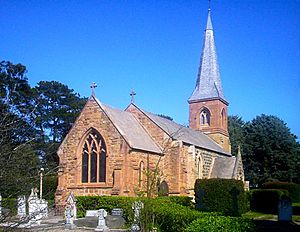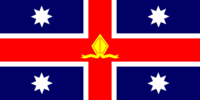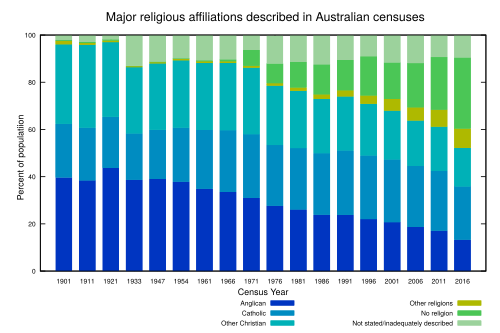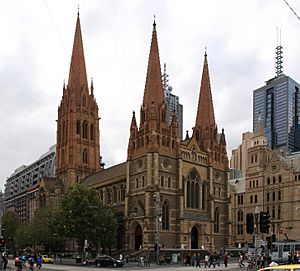Anglican Church of Australia facts for kids
Quick facts for kids Anglican Church of Australia |
|
|---|---|

|
|
| Classification | Protestant |
| Orientation | Anglican |
| Scripture | Holy Bible |
| Theology | Anglican doctrine |
| Polity | Episcopal |
| Primate | Geoffrey Smith |
| Members | 4,865,328 (2016) |
| Official website | anglican.org.au |
The Anglican Church of Australia is a Christian church in Australia. It is part of the worldwide Anglican Communion, which means it is connected to other Anglican churches around the globe. In 2016, the church reported having over 4.8 million members.
By 2021, about 2.5 million Australians identified as Anglicans. This makes it the second largest church in Australia, after the Roman Catholic Church. For a long time, the Anglican Church was the biggest religious group in Australia. However, like many churches in developed countries, its membership has decreased recently.
The church also provides many important social services across Australia.
Contents
History of the Anglican Church in Australia
When the First Fleet arrived in New South Wales in 1788, Richard Johnson was the first Church of England chaplain. He was in charge of helping the new settlement with its spiritual needs. In 1825, Thomas Hobbes Scott became the first Archdeacon of Australia. Later, William Grant Broughton became the first Bishop of Australia in 1836.

In the early days of the colony, Anglican clergy worked closely with the governors. Richard Johnson helped improve public behaviour and was involved in health and education. Another chaplain, Samuel Marsden, was also a magistrate. He was known for giving out harsh punishments.
At first, the authorities were suspicious of Roman Catholics. This was because some Irish convicts had been sent to Australia for political reasons. Roman Catholic convicts had to attend Church of England services. Their children were also raised as Anglicans.
In 1836, the Church Act of 1836 changed things. This law made all major Christian groups, like Anglicans, Roman Catholics, and Presbyterians, equal under the law. This meant the Church of England lost its special legal status.
The church tried to set up missions for Aboriginal people, but these were not very successful. Indigenous people were not keen to join the religion of the colonists who were taking their land.
Over time, more dioceses (church areas) were created. In 1842, Tasmania got its own diocese. By 1847, the rest of Australia was divided into four dioceses: Sydney, Adelaide, Newcastle, and Melbourne. By the 1920s, there were 25 dioceses.
Australia's society was mostly Anglo-Celtic, with many people being Anglican. The Australian Constitution of 1901 made sure everyone had freedom of religion.
In the early 1900s, the Church of England changed how it worshipped. It became more "Anglican" and different from other churches. There were some disagreements within the church. Some wanted the church to focus more on social problems, while others were more traditional.
The Anglican Church was the largest Christian group until 1986. After World War II, many different people moved to Australia. This led to the Roman Catholic Church becoming the largest Christian group. The number of Anglicans attending church services started to decline in 1959.
Since 1962, the Australian church has been independent. It is led by its own primate. In 1981, it officially changed its name to the Anglican Church of Australia.
The church uses different prayer books for its services. While the Book of Common Prayer is the official standard, An Australian Prayer Book was published in 1978. Another book, A Prayer Book for Australia, came out in 1995.
In 1985, the church allowed women to become deacons. In 1992, it approved allowing women to become priests. Many women were ordained as priests that year. As of November 2024, most dioceses ordain women as priests. Only two dioceses, Sydney and North-West Australia, have not. In 2008, Kay Goldsworthy became the first woman to be made a bishop in Australia. In 2014, Sarah Macneil became the first woman to lead a diocese as a bishop.
The church continues to provide many education and welfare services. It also provides chaplains for the Australian Defence Force, hospitals, schools, and prisons. Church leaders often speak out on important social issues. The current primate is Geoffrey Smith, the Archbishop of Adelaide.
Recent Church Changes
In August 2022, some conservative Anglicans formed a new group called the Diocese of the Southern Cross. This split happened because of disagreements on certain church teachings. This new diocese is supported by some leaders, including the Archbishop of Sydney, Kanishka Raffel. The Diocese of Sydney stated that this division caused a "deep breach of fellowship" within the church.
Anglican Church Members
The Anglican Church was the largest religious group in Australia from 1788 until the 1986 census. The highest percentage of Anglicans was in 1921, at 43.7% of the population. The largest number of Anglicans was in 1991, with over 4 million people.
In the 2011 Census, about 3.6 million people said they were Anglican. By the 2021 Census, this number had fallen to about 2.5 million. This shows a significant decrease in people identifying as Anglican. The number of people attending Anglican churches weekly also decreased from 1991 to 2011. This trend of declining church membership is seen in many developed countries.
One reason for fewer Anglicans is changes in Australia's immigration. Before Second World War, most immigrants came from the United Kingdom. After the war, many people from different countries moved to Australia, including many Roman Catholics.
How the Church is Organized
The Anglican Church in Australia has 23 dioceses. These dioceses are grouped into five provinces, except for Tasmania. The main churches (cathedrals) are in the capital cities of the states. Most Anglican clergy (church leaders) work in Australia's major cities. The Diocese of Sydney is the largest, with many churchgoers and clergy.
Broughton Publishing is the church's national publishing company.
Indigenous Ministry
The National Aboriginal and Torres Strait Islander Anglican Council (NATSIAC) works with Indigenous people. It appoints two Indigenous bishops for this work. Currently, Chris McLeod is the National Aboriginal Bishop.
Church's Role in Society
Welfare and Education Services
Anglicans have always played a big part in welfare and education. The first chaplain, Richard Johnson, helped with health and schools. Today, the church still provides many social welfare services. Organizations like Anglicare and Samaritans help people in need. In 2016, the Anglicare network helped about 940,000 Australians with things like emergency relief, aged care, and support for homeless people.
There are about 145 Anglican schools in Australia. These schools educate over 105,000 children. Some are small local schools, while others are large, well-known independent schools like Geelong Grammar and The Kings School in Sydney.
Church Buildings and Art

The first Church of England building in Australia was built in 1793. Many towns in Australia have at least one Christian church. St James' Church in Sydney is one of Australia's oldest Anglican churches. It was built between 1819 and 1824 by convicts.
Sydney's main Anglican church, St Andrew's, was finished in 1868. It was designed in a style similar to English cathedrals. St Paul's Cathedral, Melbourne is another famous landmark. It was designed by a famous English architect.
Tasmania has many old Anglican buildings, including some at Port Arthur, a historic convict settlement. Adelaide is known as the City of Churches, and its St Peter's Anglican Cathedral is a well-known building.
The oldest building in Canberra is St John the Baptist Church, built in 1845. This church shows the style of country chapels found across Australia. Many beautiful chapels were also built at church schools.
Women in Leadership Roles
Since 1985, the church has allowed women to be ordained as deacons. Marion Macfarlane was the first woman ordained in 1884. In 1992, the first women became priests. This started in the Diocese of Perth and then spread across the country.
In 2008, Kay Goldsworthy became the first woman to be consecrated as an assistant bishop. In 2014, Sarah Macneil became the first woman to lead a diocese as a bishop. Bishop Kay Goldsworthy later became the Archbishop of Perth in 2018.
Most of the 23 Anglican dioceses in Australia now ordain women as priests. Only two dioceses, Sydney and North West Australia, have not. The Diocese of Armidale has ordained two women as priests, but only for an Anglican girls' school.
Provinces and Dioceses
The whole church is led by the primate, Geoffrey Smith, who is the Archbishop of Adelaide.
Here are the provinces and their dioceses:
- Province of South Australia (Leader: Geoffrey Smith, Archbishop of Adelaide)
- Adelaide (Archbishop: Geoffrey Smith)
- The Murray (Vacant)
- Willochra (Jeremy James)
- Province of New South Wales (Leader: Kanishka Raffel, Archbishop of Sydney)
- Armidale (Rod Chiswell)
- Bathurst (Mark Calder)
- Canberra and Goulburn (Mark Short)
- Grafton (Murray Harvey)
- Newcastle (Peter Stuart)
- Riverina (Donald Kirk)
- Sydney (Archbishop: Kanishka Raffel)
- Province of Victoria (Leader: Archbishop of Melbourne, vacancy in see)
- Ballarat (Garry Weatherill)
- Bendigo (Matthew Brain)
- Gippsland (Richard Treloar)
- Melbourne (Archbishop: Vacant)
- Wangaratta (Clarence Bester)
- Province of Queensland (Leader: Jeremy Greaves, Archbishop of Brisbane)
- Brisbane (Archbishop: Jeremy Greaves)
- North Queensland (Keith Joseph)
- Northern Territory (Greg Anderson)
- Rockhampton (Peter Grice)
- Province of Western Australia (Leader: Kay Goldsworthy, Archbishop of Perth)
- Bunbury (Ian Coutts)
- North West Australia (Darrell Parker)
- Perth (Archbishop: Kay Goldsworthy)
- Extraprovincial diocese
- Tasmania (Richard Condie)
Map of Dioceses
| KEY to province colours | New South Wales | Victoria | Queensland | Western Australia | South Australia | Extraprovincial |

Goulburn
Some former dioceses have joined current ones or formed other Anglican churches:
- Carpentaria (now part of the Diocese of North Queensland)
- Kalgoorlie (now part of the Diocese of Perth)
- New Guinea (now the Anglican Church of Papua New Guinea)
- St Arnaud (now part of the Diocese of Bendigo)
Working with Other Churches
The Anglican Church of Australia works with other Christian churches. It is a member of the Christian Conference of Asia.
Global Anglican Connections
The Anglican Diocese of Sydney has been a key part of the Anglican realignment. This is a movement of Anglican churches that want to stick to traditional teachings. They have disagreed with some decisions made by other Anglican churches in the United States and Canada.
The Fellowship of Confessing Anglicans was started in Australia in 2015. This group brings together Anglicans who share similar traditional beliefs.
In 2017, the Anglican Church of Australia expressed its concern about the Scottish Episcopal Church's decision to allow certain changes to marriage. They said this was "contrary to the doctrine of our church."
Many Australian Anglicans attended a big meeting called GAFCON III in Jerusalem in 2018. This meeting brought together Anglicans from around the world who support traditional teachings.
In 2022, the Diocese of the Southern Cross was formed. This was the first Anglican diocese in Australia to form outside the main Anglican Church of Australia.
See also
- Christianity in Australia
- List of the first women ordained as priests in the Anglican Church of Australia in 1992





